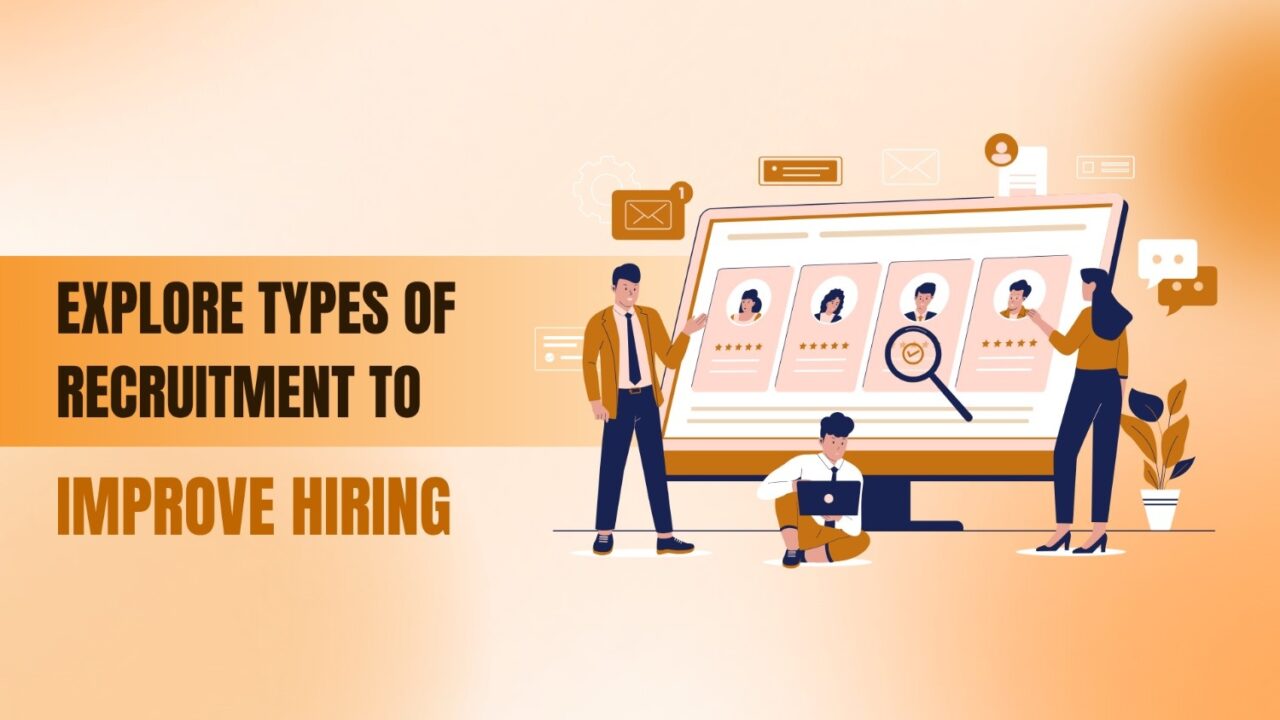In 2025, the hiring challenges in India are reaching new heights, with a growing talent gap. 80% of employers across India are struggling to find skilled professionals, a challenge common across business hubs like Bengaluru, Chennai, Hyderabad, Pune, Mumbai, and Delhi NCR. Organisations in sectors ranging from IT to shared services are facing severe role-to-talent mismatches.
As businesses compete for top talent, understanding the various types of recruitment becomes an important step in the hiring process.
In this guide, we explore the types of recruitment shaping India’s talent ecosystem in 2025. You’ll discover which methods best suit your business needs and actionable insights to help you attract and retain the right talent in a rapidly evolving market.
Key Takeaways
- Understand the differences between internal and external recruitment, including key methods and when to use each.
- Explore modern recruitment models like permanent hiring, contract staffing, RPO, and executive search, and their role in today’s hiring landscape.
- Learn how to choose the right recruitment model based on company size, urgency, role type, and internal capacity.
- Avoid common mistakes and see how V3 Staffing helps build recruitment strategies aligned to business goals.
What Are the Main Types of Recruitment?
Recruitment approaches can broadly be classified into Internal and External methods. Each type plays a specific role depending on the organisation’s scale, urgency, role criticality, and hiring infrastructure.
1. Internal Recruitment
Internal recruitment refers to the process of identifying and filling open roles using existing or former employees, rather than sourcing externally.
It is commonly used by mid-to-large Indian enterprises, particularly in shared service centres, GCCs, and manufacturing units as part of workforce continuity, upskilling strategies, or cost containment.
This method uses the employer’s existing human capital: people who already understand the company’s systems, culture, and expectations, thereby reducing onboarding time and integration risk.
Key Forms of Internal Recruitment
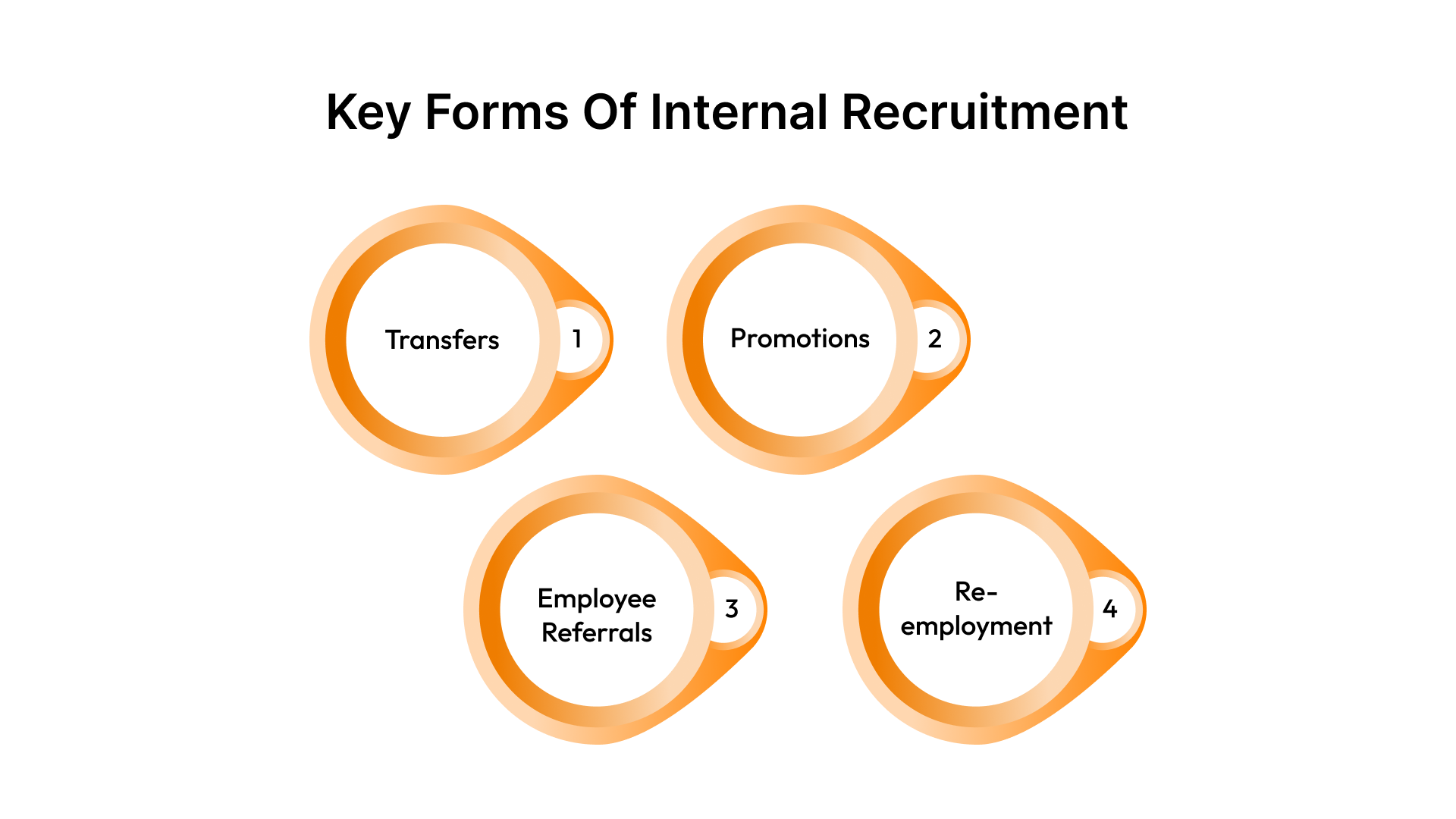
1. Transfers
A transfer is a lateral shift of an employee to another role, department, or location, typically without a change in pay or rank.
Use case: Realigning workforce with business shifts. For e.g., moving a support lead from Pune to Mumbai as new operations expand.
2. Promotions
Promotions involve advancing employees to a higher-level role with increased responsibility and compensation.
Use case: Retaining high-performing managers in shared services or tech functions, often seen in centres based in Hyderabad or Chennai.
3. Employee Referrals
Employees are incentivised to refer candidates from their networks for open roles. This method technically sources externally but is internally driven.
Use case: Cost-effective for mid-level tech or sales roles in Bengaluru or Delhi NCR, where time-to-fill is critical.
4. Re-employment (Boomerang Employees)
Rehiring former employees who previously left the organisation and are now available with added experience.
Use case: Useful in high-attrition sectors like BFSI or IT, where former performers are already known quantities.
When Internal Recruitment Works Best
- Backfilling urgent vacancies without time for a full external cycle
- Retaining institutional knowledge, particularly in domain-heavy functions (e.g. compliance, finance)
- Maintaining morale and succession planning pipelines
- Cost-sensitive hiring environments, particularly in support and shared service units
- Organisations with active internal mobility frameworks: common in large Indian corporates or MNCs in Tier 1 and Tier 2 cities
Pros and Cons of Internal Recruitment
| Advantages | Limitations |
| Reduces time-to-hire and onboarding costs | May cause skill stagnation if new ideas are not introduced |
| Improves retention and morale by demonstrating career growth opportunities | Risk of internal bias or limited evaluation objectivity |
| Candidates already understand organisational systems and compliance processes | Internal movement may open up another vacancy to be filled |
| Lowers hiring spend compared to external methods | Smaller talent pool may not suit specialist or emerging tech roles |
Pro Tip: Internal recruitment is one of the most effective types of recruitment when embedded in structured talent planning and not as an ad hoc fix. Without clear success metrics or mobility support, it can inadvertently fuel poor fitments or missed opportunities.
In high-skill, fast-moving sectors such as tech product firms in Bengaluru or regulated BFSI setups in Mumbai, internal hiring must be complemented with external sourcing for innovation, speed, and bench strength.
2.External Recruitment
External recruitment refers to sourcing talent from outside the organisation to fill open roles. It is essential when internal resources are limited or unsuitable, particularly for roles that demand specialised expertise, fresh skill sets, or rapid scaling.
This approach is widely used across industries where hiring needs often outpace internal capacity or where niche roles must be filled with precision.
Key Methods of External Recruitment
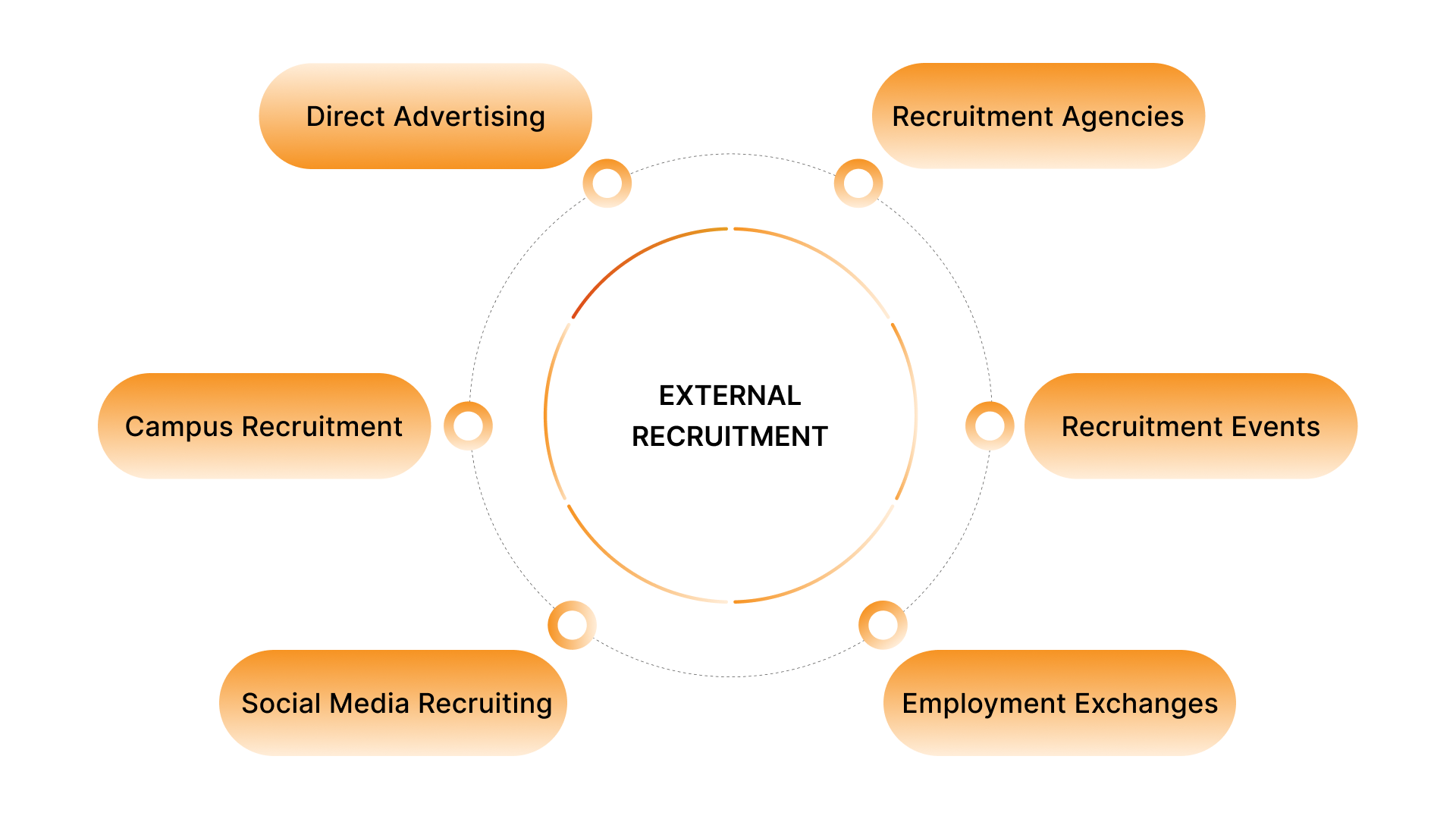
1. Direct Advertising (Job Portals, Career Sites, Print Media)
Job postings on platforms such as LinkedIn, Naukri, or the company’s career site.
Use case: Suitable for standardised roles or when organisations want full control of the pipeline.
Note: Print ads are rarely used today except in certain public-sector or legacy cases.
2. Recruitment Agencies (Contingency & Retained Search)
Agencies manage all or part of the recruitment process, especially for mid-to-senior roles or when internal bandwidth is limited.
Contingency: Paid only on successful placement
Retained: Engaged upfront, typically for senior, niche, or confidential roles
V3 Staffing offers industry-specialised, SLA-driven recruitment delivery with access to pre-vetted talent pools. Their domain-led recruiters and scalable models make them a reliable partner for consistent hiring outcomes. Whether scaling tech teams, filling leadership roles, or hiring at scale, V3 delivers speed, precision, and accountability aligned to your hiring goals.
3. Campus Recruitment
Sourcing fresh graduates from academic institutions through placement drives or campus partnerships.
Use case: Entry-level hiring for tech, operations, sales, or service support roles.
4. Recruitment Events (Job Fairs, Hackathons, Walk-ins)
Offline or hybrid events where organisations engage directly with talent.
Use case: Mass hiring initiatives or sourcing specific skill sets (e.g., coders through hackathons).
5. Social Media Recruiting
Utilising platforms such as LinkedIn, Twitter, or WhatsApp to post jobs, run targeted outreach campaigns, or engage passive candidates.
Use case: Useful for lateral and niche hiring, especially when traditional channels are saturated.
6. Employment Exchanges & Public Sector Channels
Government-led recruitment channels mainly used for semi-skilled or blue-collar hiring.
Use case: More prevalent in public-sector hiring or state-mandated staffing initiatives.
When External Recruitment Works Best
- When internal pipelines are thin or already tapped out
- For specialist or hard-to-fill roles not available internally
- To enable faster expansion, especially in new verticals or business units
- When seeking diverse, external perspectives to drive innovation
- For hiring at scale, where high-volume intake is required
- For confidential searches, particularly in leadership or transformation roles
Pros and Cons of External Recruitment
| Advantages | Limitations |
| Access to broader, more specialised talent pools | Typically higher cost per hire |
| Injects fresh thinking and new capabilities | Onboarding and cultural integration may take longer |
| Supports business growth when scaling teams or functions | Variable candidate quality needs vetting and process rigour |
| Effective for high-impact or niche hiring when internal teams lack capacity | Longer hiring cycles if poorly scoped or unstructured |
Strategic Tip: External recruitment is most effective when paired with a clear sourcing strategy and accountability framework. Partnering with a recruitment agency that understands both industry-specific talent needs and operational execution is critical, especially for organisations with multi-functional hiring mandates or lean internal HR teams.
Choosing the right external recruitment channel, and the right partner can significantly reduce time-to-fill, cost-per-hire, and candidate attrition risk.
While understanding internal and external recruitment is essential, today’s hiring challenges demand more flexible, outcome-focused models.
Modern Recruitment Models You Should Know in 2025
When speed, skill accuracy, and scalability are business-critical, companies increasingly need to go beyond basic internal or external recruitment. They are adopting purpose-built recruitment models that align with the complexity, urgency, and level of roles.
The models below are the most relevant for Indian organisations and MNCs operating domestically, particularly across sectors such as IT, BFSI, shared services, and manufacturing.
1. Permanent Recruitment
Permanent recruitment is the process of identifying and placing full-time employees into long-term roles within the organisation. It is best suited for core business functions where employee stability, retention, and domain alignment are essential.
Why It Matters:
- Permanent hires own institutional knowledge and drive long-term performance.
- Domain-fit (e.g., actuarial for insurance, SAP for manufacturing) is critical for productivity and retention.
- Strategic functions like finance, compliance, core engineering depend heavily on permanent roles.
Hiring permanent staff without a structured process can lead to poor-fit placements. V3 Staffing’s Permanent Recruitment, with domain-specific sourcing and SLA-bound delivery, reduces mismatch risk while accelerating time-to-hire.
3. Contract Staffing / Temporary Hiring
Contract or temporary staffing involves deploying employees for a fixed period, usually for a specific project, seasonal workload, or urgent business requirement. It is often used to bridge talent gaps quickly without long-term headcount commitment.
Where It Works:
- Project-based roles (e.g. software rollouts, audits, data clean-ups)
- Pilot or trial teams before permanent structures are formalised
- Short-term hiring surges due to seasonal peaks or market expansion
Key Features:
- Scalability: Teams can be ramped up or down quickly
- Speed: Faster deployment timelines
- Flexibility: No long-term liabilities
Compliance Considerations:
- Legal and statutory compliance for contract workers is non-negotiable.
- Many firms engage staffing partners to manage compliance, payroll, and documentation to avoid operational risk.
This model is increasingly popular in IT and support services, where agile resourcing is critical. V3’s temporary staffing offers compliance-backed contract deployment, ensuring workforce elasticity without legal exposure.
3. Recruitment Process Outsourcing (RPO)
RPO is a model where an external recruitment partner manages all or part of the hiring function, operating as an embedded extension of the client’s talent acquisition team. This is not staffing, it is process ownership with measurable outcomes.
What It Really Means:
- Dedicated recruiters, fully aligned with internal HR policies
- Embedded within the client’s ATS, HR tech, and interview workflows
- Accountable for metrics like time-to-fill, quality-of-hire, and offer-to-join ratios
When to Choose RPO:
- When you are scaling across functions or geographies
- If internal HR is overburdened or under-resourced
- For long-term cost optimisation and SLA-based hiring operations
- During mergers, shared service expansion, or new BU creation
Advantage: Unlike contingency recruitment, RPO builds recruitment infrastructure, not just placements. It’s a strategic model, often adopted by GCCs and multi-location Indian enterprises aiming for sustained hiring velocity.
V3 Staffing delivers fully embedded RPO teams, calibrated by industry and role type, supported by performance dashboards and recruitment analytics. This enables businesses to run hiring like a KPI-driven function, not a transactional one.
4. Executive Search / Leadership Hiring
Executive search focuses on hiring for CXO, VP, Director, and other senior strategic roles that require discretion, precision, and long-term alignment. It is not the same as high-end recruitment, it involves a rigorous, mapped process.
What Makes It Different:
- Involves passive talent: leaders not actively job-hunting
- Prioritises competency frameworks, not just title or skill match
- Requires confidentiality, especially in succession planning or stealth transitions
- Longer lead times, but higher stakes and higher impact
Common Misuse: Many firms approach senior hiring like any other role, posting on job boards or looping in junior recruiters. This leads to poor perception among candidates, low-quality pipelines, and reputational damage.
When to Use Executive Search:
- CXO succession or transformation roles
- Roles requiring strategic alignment and stakeholder management
- Leadership hiring in new business units or under NDA conditions
V3’s executive search runs competency-led, discreet search mandates across industries, helping organisations hire leaders who are not just qualified, but role-ready and culturally aligned.
5. Passive Candidate Recruitment
Passive recruitment targets individuals who are not actively seeking jobs but may consider new opportunities under the right conditions.
Methods Include:
- Long-term talent pipeline mapping
- Building and nurturing employer branding
- Referral networks and targeted outreach (especially effective for tech and product roles)
Why It Matters:
- Top-performing candidates are often not looking, they’re doing.
- Passive talent pools yield higher offer-to-join ratios if approached strategically.
- It is essential for roles with limited supply, such as AI/ML engineers, cloud architects, or transformation leaders.
6. Outplacement & Reverse Recruiting (Optional Strategic Add-on)
While not a hiring model per se, these are strategic workforce tools often deployed during transitions:
- Outplacement: Supporting laid-off employees with coaching, CV support, and placement services
- Reverse recruiting: Internally helping employees transition into better-fit roles, reducing unwanted attrition
These models contribute to employer brand, internal mobility, and talent lifecycle management.
Looking for quicker hiring outcomes and the right talent fit? Explore V3 Staffing for your unique recruitment needs and see how our proven approach can tackle your talent challenges.
Understanding the types of recruitment and recruitment models is only useful if you can apply them effectively. Choosing the right one starts with assessing your hiring context and priorities.
Also Read: Difference Between Staffing vs RPO vs Contract Hiring Vs Permanent Hiring
Key Factors to Consider Before Selecting a Recruitment Type
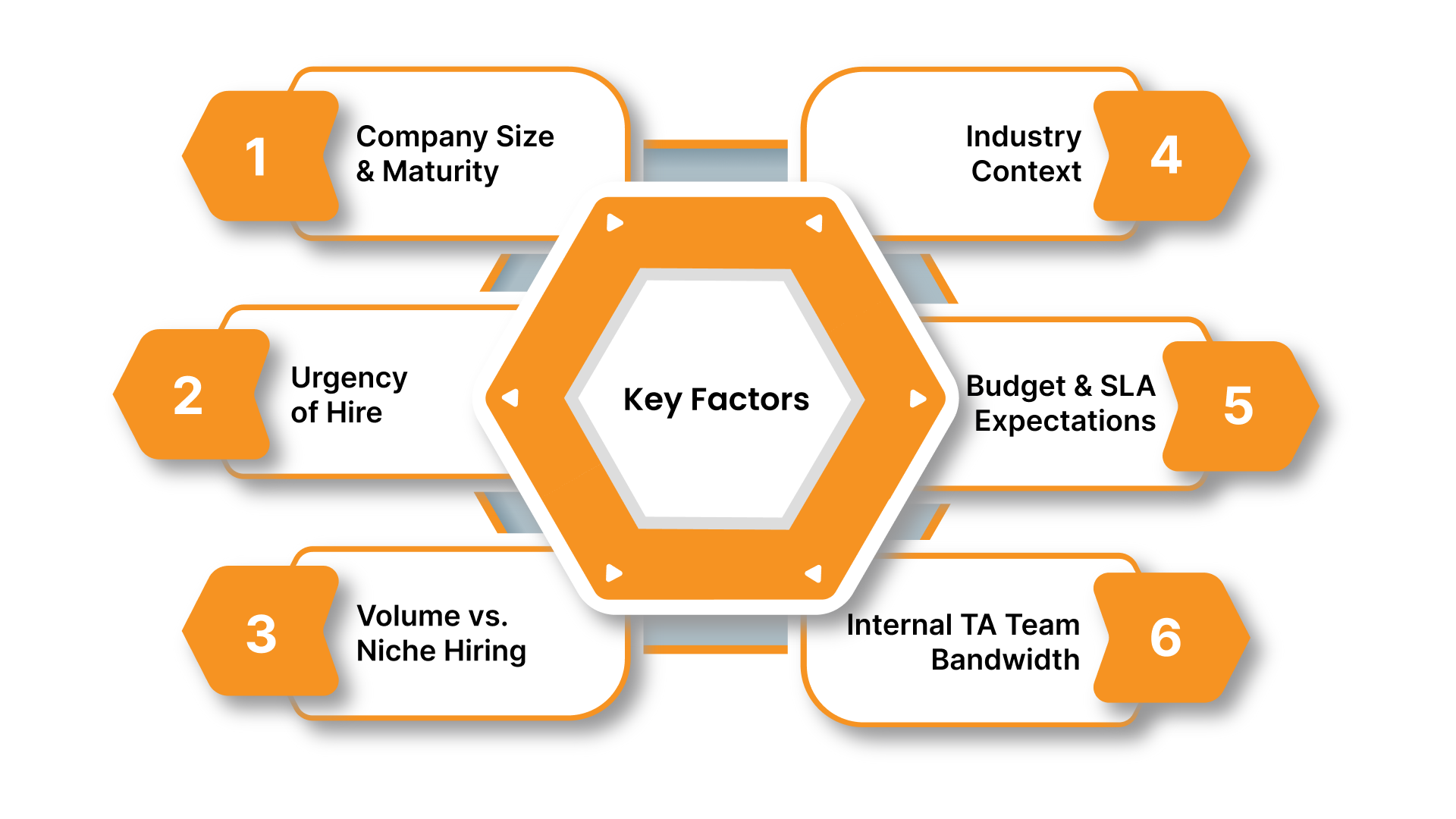
Before choosing a hiring approach, evaluate the following variables. These will guide whether you need in-house solutions, external support, or a more scalable hybrid model.
1. Company Size and Maturity
- Startups may favour flexible or contract models to stay lean.
- Mid-sized and enterprise firms often require a structured mix: permanent hiring for core roles, RPO for scale, and executive search for leadership.
2. Urgency of Hire
If a role is business-critical or tied to a project deadline, a contract staffing or retained search model ensures speed and accountability.
3. Volume vs. Niche Hiring
- High-volume hiring: Consider RPO or bulk contract staffing.
- Niche/specialist roles: Permanent hiring with domain-focused sourcing or executive search.
4. Industry Context
- Tech & GCCs: Often rely on agile, SLA-bound models like contract or RPO.
- BFSI & Engineering: Require compliance, credential checks, and strong domain fit: permanent hiring or retained search works best.
- Shared Services: RPO brings process consistency across functions.
5. Budget and SLA Expectations
- SLA-driven models (RPO, retained search) provide more transparency and cost predictability.
- Transactional models (job boards, contingency hiring) may offer flexibility but often lack accountability.
6. Internal TA Team Bandwidth
If internal recruiters are overloaded or lack specific expertise, outsourcing part or all of the hiring function through RPO or agency support delivers better consistency and time-to-fill performance.
Quick Reference Matrix: Matching Hiring Needs with Recruitment Models
| Hiring Need | Best-Fit Recruitment Type | Why It Works |
| 1–2 niche tech roles | Executive Search or Specialist Permanent Hiring | Precision sourcing, passive candidate targeting, domain-fit critical |
| Scale-up across 4 cities | Contract Staffing + RPO | Scalable model for multi-location rollout with embedded execution |
| CXO attrition risk | Executive Search | Confidential search, deep competency mapping, high-stakes alignment |
| Launching a shared services unit | RPO | Structured hiring engine with ownership, aligned to multi-function delivery |
| Urgent backfills in BFSI roles | Contract Staffing | Fast deployment, compliance-managed, high fill rate for support/mid-level roles |
| High-attrition mid-level teams | Hybrid (RPO + Referral + Contract) | Balance of quality, retention, and hiring velocity |
| New function or BU buildout | RPO + Permanent Recruitment | Embedded hiring with leadership-layer support |
Also Read: How Predictive Analytics is Revolutionising Talent Acquisition
Even with the right criteria in place, missteps are common. Avoiding these mistakes is just as important as knowing what to look for.
Common Mistakes to Avoid When Choosing a Recruitment Model
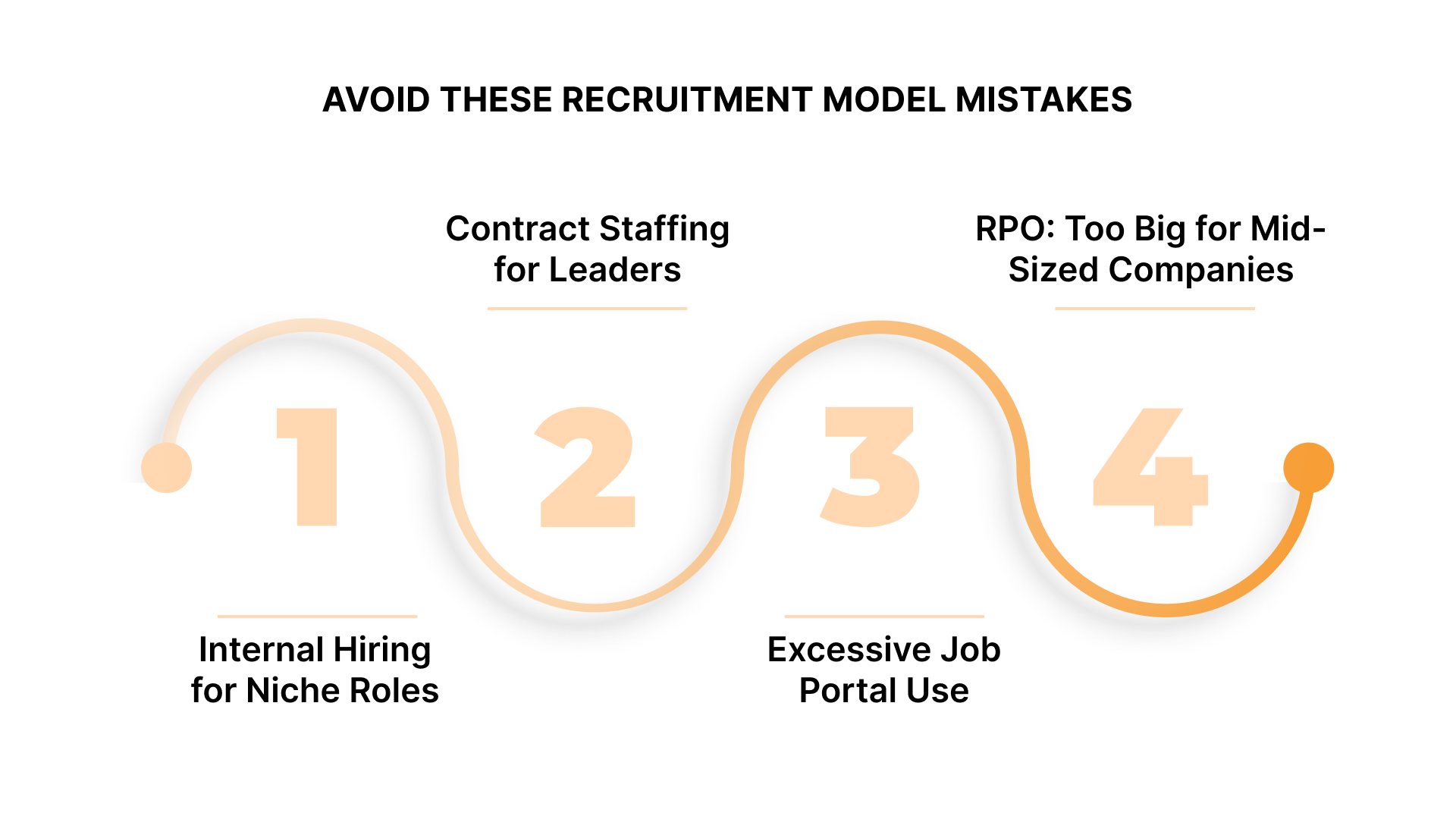
Selecting the wrong hiring model can lead to wasted time, poor candidate fit, or unmet business goals. Here are common pitfalls to watch for and why they matter:
1. Defaulting to Internal Hiring for Niche Roles
Relying solely on internal talent for highly specialised positions often fails. These roles typically require external market access and passive sourcing, something internal mobility can’t provide.
2. Using Contract Staffing for Leadership Positions
Leadership roles demand long-term strategic alignment. Contract staffing lacks the continuity and discretion needed for CXO or director-level positions, risking instability and poor cultural fit.
3. Overusing Job Portals Without Filtration
Mass sourcing through portals without proper vetting tools leads to low-quality pipelines and high rejection rates. It increases time-to-fill and burdens internal HR with irrelevant profiles.
4. Assuming RPO is “Too Big” for Mid-Sized Companies
RPO isn’t just for large enterprises. In fact, mid-sized firms benefit the most from embedded recruitment support when scaling, helping reduce hiring costs and improve delivery consistency.
If you’re seeking faster hiring results and quality talent matches, explore V3 Staffing for your specific hiring needs and discover how our proven success can solve your talent challenges.
Also Read: 5 Ways Recruitment Agencies Can Tackle High Attrition Rates
Conclusion
Choosing the right type of recruitment is about aligning hiring strategy with business priorities, timelines, and talent realities. Whether you’re building a leadership team, expanding a function, or addressing scale, each model serves a different purpose. The real advantage lies in knowing when to use which. Organisations that treat recruitment as a strategic lever and not a back-office task see better outcomes across quality, retention, and speed.
Looking to build a recruitment model that fits your business, not the other way around?
Contact V3 Staffing to explore tailored hiring solutions built for precision, scale, and accountability.
FAQs
Q. What are the legal considerations when choosing between different types of recruitment in India?
A. Each recruitment type: permanent, contract, or third-party comes with different compliance requirements under Indian labour laws. For example, contract staffing must follow regulations under the Contract Labour (Regulation and Abolition) Act, and benefits like PF/ESI must be managed accurately.
Q. Can multiple recruitment types be used simultaneously within the same organisation?
A. Yes. Most mid to large organisations blend models for e.g., RPO for scale, executive search for leadership, and permanent hiring for core roles to meet different workforce needs across departments.
Q. How do recruitment types impact employer branding?
A. Using the wrong model like frequent short-term contracts for strategic roles can signal instability. Strategic use of recruitment types ensures candidates experience consistency, clarity, and professionalism.
Q. Are certain types of recruitment better suited for remote or hybrid teams?
A. Contract staffing and project-based models are often more effective for remote roles, offering flexibility and quicker onboarding. Permanent recruitment may still apply for remote leadership or specialist roles.
Q. How does technology influence the effectiveness of different recruitment types?
A. ATS platforms, AI-driven screening, and recruitment analytics improve speed and precision across all models, but are especially critical in RPO and high-volume hiring where data tracking and reporting are essential.

